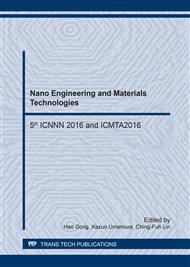p.8
p.13
p.19
p.24
p.32
p.37
p.42
p.48
p.55
Synthesis of Porous Carbon Material and its Use for Growing Carbon Nanotubes
Abstract:
The scales of porous carbon materials usage are constrained by their considerably high cost. Therefore, development of new methods for production of porous carbon with the necessary complex of properties from cheap raw materials is actual. Also, porous carbon materials can be used for growth of carbon nanotubes as a matrices of catalyst particles. Herein, the method of fabrication porous carbon materials from waste of oil industry and their use as a matrices of catalyst particles to growth of CNT was developed. CNTs was synthesized by CVD using as hydrocarbon source - propan-butane gas mixture, as catalyst - Ni particles at 650°C, 700°C, 750°C, 800°C. Obtained carbon materials was investigated by Raman spectroscopy and by scanning electron microscope. Investigations on the properties of the obtained porous materials show soot particles sedimented in pores reduce well nanoparticles of metals from salts which act as nuclei for the growth of multiwall carbon nanotubes during pyrolysis of hydrocarbons by CVD method.
Info:
Periodical:
Pages:
32-36
Citation:
Online since:
March 2017
Keywords:
Price:
Сopyright:
© 2017 Trans Tech Publications Ltd. All Rights Reserved
Share:
Citation:


